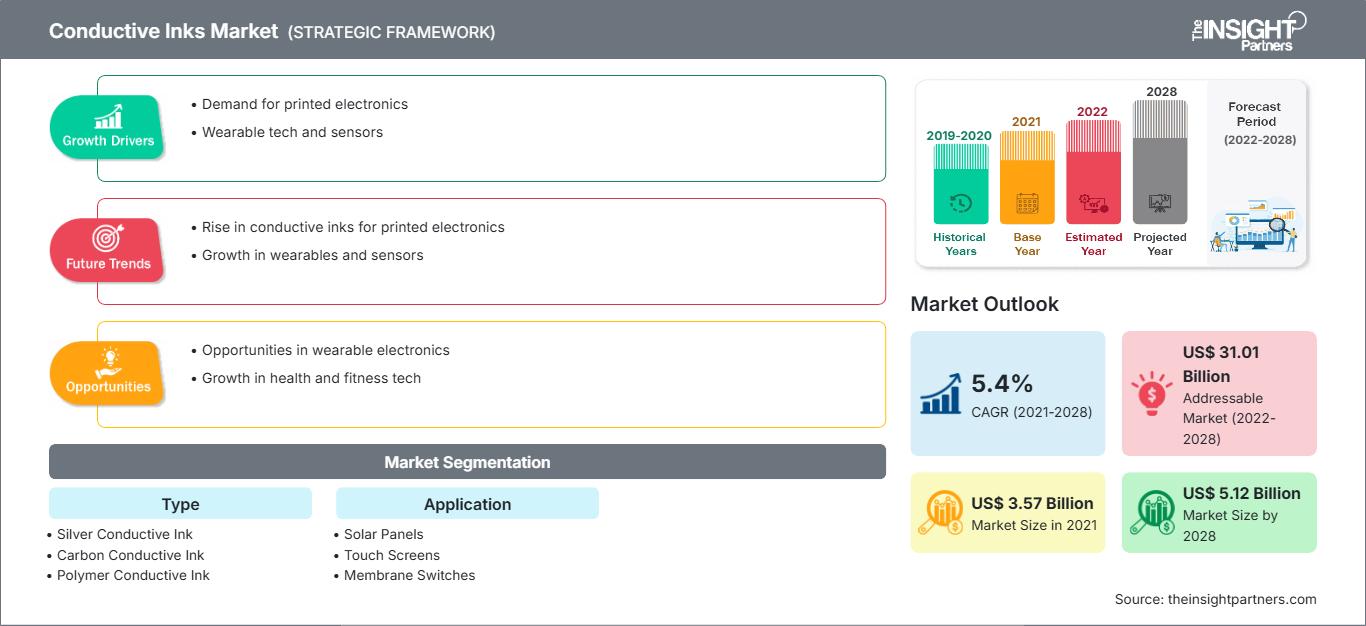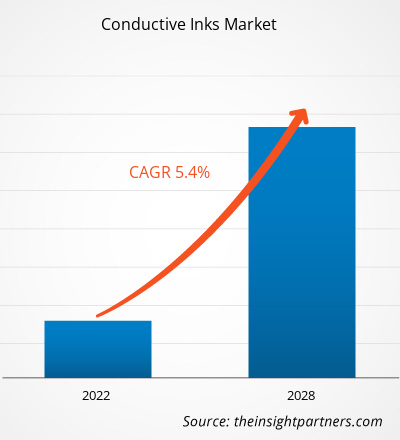[Forschungsbericht]Der Markt für leitfähige Tinten wird voraussichtlich von 3.565,80 Millionen US-Dollar im Jahr 2021 auf 5.119,80 Millionen US-Dollar im Jahr 2028 wachsen; von 2022 bis 2028 wird ein CAGR von 5,4 % geschätzt.
Regierungen auf der ganzen Welt haben Umweltschutzauflagen erlassen, um die Industrie zu ermutigen, schwere Materialien in Geräten durch moderne, leichte Materialien zu ersetzen. Darüber hinaus hat der Wunsch der Verbraucher nach winziger und leichter Elektronik die Unterhaltungselektronikindustrie dazu veranlasst, ihre Produkte zu miniaturisieren. Darüber hinaus wird erwartet, dass die schnell zunehmende Zahl von IoT-basierten Anwendungen und der zunehmende Miniaturisierungstrend die Nachfrage nach leitfähigen Tinten ankurbeln. Die schnell zunehmende Nutzung von Smartphones und vernetzten Geräten treibt den Bedarf an kleineren und leichteren Sensoren mit geringem Stromverbrauch und verbesserter Leistung voran, was die Nachfrage nach Miniaturisierung ankurbelt. China dominiert die gesamte Wertschöpfungskette der globalen Elektronikfertigung und investiert massiv in neue Techniken, um schnell miniaturisierte Elektronikprodukte herzustellen. Die wachsende Nachfrage nach Miniaturisierung bei Smartphones, Wearables und anderen Gadgets sowie die steigende Nachfrage nach effizienten elektronischen Geräten stärken daher die Marktgröße für leitfähige Tinten.
Passen Sie diesen Bericht Ihren Anforderungen an
Sie erhalten kostenlos Anpassungen an jedem Bericht, einschließlich Teilen dieses Berichts oder einer Analyse auf Länderebene, eines Excel-Datenpakets sowie tolle Angebote und Rabatte für Start-ups und Universitäten.
Markt für leitfähige Tinten: Strategische Einblicke

-
Holen Sie sich die wichtigsten Markttrends aus diesem Bericht.Dieses KOSTENLOSE Beispiel umfasst Datenanalysen, die von Markttrends bis hin zu Schätzungen und Prognosen reichen.
Auswirkungen der COVID-19-Pandemie auf den Markt für leitfähige Tinten
Viele Hersteller flexibler und gedruckter Elektronik waren aufgrund der COVID-19-Pandemie mit Arbeitskräftemangel konfrontiert. Die Nachfrage nach leitfähiger Tinte für gedruckte elektronische Anwendungen, wie z. B. den Druck von RFID-Tags in modernen Fahrkarten und Scheibenheizungen in Kraftfahrzeugen, trägt zum Wachstum des Marktes für leitfähige Tinten bei. Darüber hinaus hat sich der Produktionsrückgang in der Automobilindustrie negativ auf den Markt ausgewirkt. Laut der Internationalen Organisation der Kraftfahrzeughersteller (OICA) betrug der weltweite Fahrzeugabsatz in den Jahren 2019 und 2020 91.227.182 bzw. 78.774.320 Fahrzeuge. Somit wirkt sich der Rückgang der Fahrzeugverkäufe negativ auf den Markt aus, da leitfähige Tinte für die Anwendung von Fahrzeugschaltkreisen und gedruckten Heizungen, insbesondere an Heckscheiben, in Kraftfahrzeugen verwendet wird. Ab Mitte 2021 treibt jedoch die Wiederaufnahme von Ölförderungsprojekten das Wachstum des Marktes für leitfähige Tinten voran. Vor der Pandemie trieben jedoch die wachsende Automobilindustrie in Nordamerika, die zunehmende Verbreitung von Elektrofahrzeugen und das zunehmende Gesundheitsbewusstsein die Nachfrage nach Miniaturisierung von Geräten voran. Die Unterhaltungselektronikbranche verzeichnete ein Wachstum. Auch die steigende Nachfrage nach kleinen und leichten elektronischen Geräten wie tragbaren Sportuhren und elektronischen medizinischen Geräten zur Gesundheitsüberwachung fördert das Wachstum des Marktes für leitfähige Tinten.
Markteinblicke – Markt für leitfähige Tinten
Zunehmende Installation von Solarmodulen treibt das Wachstum des Marktes für leitfähige Tinten voran
Der steigende Energiebedarf erfordert die Nutzung alternativer Energiequellen. Daher werden nun erneuerbare Energiequellen, insbesondere Solarenergie, zur Stromerzeugung eingesetzt. Die zunehmende Nutzung von Solarenergie zur Stromerzeugung wird voraussichtlich die Nachfrage nach solarbasierter Technologie ankurbeln und den Einsatz von Solarmodulen in den kommenden Jahren steigern. Dies schafft Chancen für den Markt für leitfähige Tinten in der Photovoltaik. Mittels Tintenstrahldruck werden mit leitfähiger Tinte organische Photovoltaik-Solarzellenmodule auf sehr dünne, flexible Oberflächen gedruckt. Der Solarsektor (Photovoltaik) steht unter erheblichem Druck, die Rohstoffkosten zu senken und die Produktionseffizienz zu steigern, um mit den bestehenden Stromnetzen konkurrieren zu können. Leitfähige Tinten sind hier eine potenzielle Lösung für die Branche und treiben den Markt für leitfähige Tinten voran.
Typbasierte Erkenntnisse
Basierend auf dem Typ ist der Markt für leitfähige Tinten in Silberleittinte, Kohlenstoffleittinte, Polymerleittinte, Kupferleittinte und weitere unterteilt. Das Segment der Kohlenstoffleittinte hatte 2021 den größten Marktanteil. Kohlenstoffleittinten sind gleitfähig, bieten geringe Reibung und ausgezeichnete thermische Stabilität. Die Tinten werden im Siebdruck, Tauchverfahren und zur Spritzendosierung verwendet und zeichnen sich durch eine ausgezeichnete Haftung auf Glas und einer Vielzahl anderer Substrate aus. Im Gegensatz zu herkömmlichen leitfähigen Materialien sind Kohlenstofftinten abrieb-, kratz-, biege- und knitterfest. Die Entwicklung leitfähiger Tinten wurde durch das schnelle Wachstum des Sektors für gedruckte Elektronik gefördert. Die leitfähigen Füllstoffe kohlenstoffbasierter leitfähiger Tinten waren weit verbreitet, günstig, gut stabil und hatten einen hohen Anwendungswert. Nanoshel LLC, Henkel und Dycotec Materials Ltd gehören zu den Hauptakteuren auf dem Markt für leitfähige Kohlenstofftinten. Die Präsenz dieser Akteure trägt zum Marktwachstum bei.
Akteure auf dem Markt für leitfähige Tinten konzentrieren sich hauptsächlich auf die Entwicklung fortschrittlicher und effizienter Produkte.
- Im Jahr 2022 kündigte DuPont Microcircuit and Component Materials die Einführung von 5881 an, einer neuen leitfähigen Silber/Silberchlorid-Tinte/Paste für Anwendungen im Gesundheitswesen.
- Im Jahr 2021 gab DuPont den erfolgreichen Abschluss der Übernahme von Laird Performance Materials bekannt, einem weltweit führenden Anbieter von Hochleistungslösungen für elektromagnetische Abschirmung und Wärmemanagement.
Regionale Einblicke in den Markt für leitfähige Tinten
Die Analysten von The Insight Partners haben die regionalen Trends und Faktoren, die den Markt für leitfähige Tinten im Prognosezeitraum beeinflussen, ausführlich erläutert. In diesem Abschnitt werden auch die Marktsegmente und die geografische Lage in Nordamerika, Europa, dem asiatisch-pazifischen Raum, dem Nahen Osten und Afrika sowie Süd- und Mittelamerika erörtert.
Umfang des Marktberichts zu leitfähigen Tinten
| Berichtsattribut | Einzelheiten |
|---|---|
| Marktgröße in 2021 | US$ 3.57 Billion |
| Marktgröße nach 2028 | US$ 5.12 Billion |
| Globale CAGR (2021 - 2028) | 5.4% |
| Historische Daten | 2019-2020 |
| Prognosezeitraum | 2022-2028 |
| Abgedeckte Segmente |
By Typ
|
| Abgedeckte Regionen und Länder |
Nordamerika
|
| Marktführer und wichtige Unternehmensprofile |
|
Dichte der Marktteilnehmer für leitfähige Tinten: Verständnis ihrer Auswirkungen auf die Geschäftsdynamik
Der Markt für leitfähige Tinten wächst rasant. Die steigende Nachfrage der Endverbraucher ist auf Faktoren wie veränderte Verbraucherpräferenzen, technologische Fortschritte und ein stärkeres Bewusstsein für die Produktvorteile zurückzuführen. Mit der steigenden Nachfrage erweitern Unternehmen ihr Angebot, entwickeln Innovationen, um den Bedürfnissen der Verbraucher gerecht zu werden, und nutzen neue Trends, was das Marktwachstum weiter ankurbelt.

- Holen Sie sich die Markt für leitfähige Tinten Übersicht der wichtigsten Akteure
Der Markt für leitfähige Tinten ist nach Typ und Anwendung segmentiert. Nach Typ ist der Markt in leitfähige Silbertinte, leitfähige Kohlenstofftinte, leitfähige Polymertinte, leitfähige Kupfertinte und andere unterteilt. Im Jahr 2021 war das Segment der leitfähigen Kohlenstofftinte marktführend und hatte den größten Marktanteil. Hinsichtlich der Anwendung ist der Markt in Solarmodule, Touchscreens, Folientastaturen, medizinische Geräte, Leiterplatten, Sensoren, Heizelemente, RFID, Handyantennen, Automobile und andere segmentiert. Im Jahr 2021 war das Segment der Leiterplatten marktführend und hatte den größten Marktanteil. Geografisch ist der Markt für leitfähige Tinten grob in Nordamerika, Europa, Asien-Pazifik (APAC), Naher Osten und Afrika (MEA) und Südamerika (SAM) segmentiert. Im Jahr 2021 hatte APAC einen bedeutenden Anteil am Weltmarkt.
Applied Ink Solutions; DuPont DE Nemours, Inc.; Henkel AG und CO. KGAA; Inkron OY; Zu den wichtigsten Unternehmen auf dem Markt für leitfähige Tinten gehören Inktec, Heraeus, Novacentrix, POLY-INK, Merck KGAA und Vorbeck Materials Corporation.
- Historische Analyse (2 Jahre), Basisjahr, Prognose (7 Jahre) mit CAGR
- PEST- und SWOT-Analyse
- Marktgröße Wert/Volumen – Global, Regional, Land
- Branchen- und Wettbewerbslandschaft
- Excel-Datensatz
Aktuelle Berichte
Erfahrungsberichte
Grund zum Kauf
- Fundierte Entscheidungsfindung
- Marktdynamik verstehen
- Wettbewerbsanalyse
- Kundeneinblicke
- Marktprognosen
- Risikominimierung
- Strategische Planung
- Investitionsbegründung
- Identifizierung neuer Märkte
- Verbesserung von Marketingstrategien
- Steigerung der Betriebseffizienz
- Anpassung an regulatorische Trends






















 Kostenlose Probe anfordern für - Markt für leitfähige Tinten
Kostenlose Probe anfordern für - Markt für leitfähige Tinten